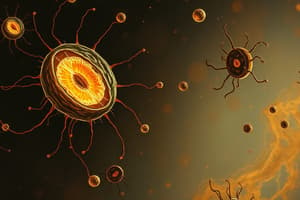Podcast
Questions and Answers
What is the primary characteristic of stem cells?
What is the primary characteristic of stem cells?
- They are fully specialized cells.
- They are only found in adult organisms.
- They can differentiate into specific types of cells. (correct)
- They cannot differentiate into new cells.
Adult and embryonic stem cells are the same.
Adult and embryonic stem cells are the same.
False (B)
What does diffusion refer to in terms of particle movement?
What does diffusion refer to in terms of particle movement?
The movement of particles from an area of high concentration to an area of low concentration.
Match the terms related to diffusion with their descriptions:
Match the terms related to diffusion with their descriptions:
What is the main factor that affects the rate of diffusion by providing more kinetic energy to particles?
What is the main factor that affects the rate of diffusion by providing more kinetic energy to particles?
Diffusion requires energy and is considered an active process.
Diffusion requires energy and is considered an active process.
Name two smaller molecules that can pass through a partially permeable membrane.
Name two smaller molecules that can pass through a partially permeable membrane.
Oxygen moves from a ______ concentration in the alveoli to a ______ concentration in the capillary.
Oxygen moves from a ______ concentration in the alveoli to a ______ concentration in the capillary.
Match the following factors to their effects on diffusion:
Match the following factors to their effects on diffusion:
Flashcards are hidden until you start studying
Study Notes
Stem Cells
- Stem cells differentiate into new cells, which can then specialize into specific cells.
- Embryonic stem cells can differentiate into any cell, making them more versatile than adult stem cells.
- Adult stem cells have a more limited differentiation potential, but they can still contribute to tissue repair.
- Many stem cell treatments are still experimental and come with inherent risks, including rejection and ethical concerns.
Diffusion
- Diffusion is the movement of particles from an area of high concentration to an area of low concentration.
- Particles move down a concentration gradient, meaning from a region with more particles to a region with fewer particles.
- Diffusion is a passive process, meaning it doesn't require additional energy to occur.
Factors Affecting Diffusion
- Temperature: Higher temperatures increase kinetic energy of molecules, leading to faster diffusion.
- Surface area: Larger surface areas provide more space for diffusion, resulting in faster rates.
- Concentration gradient: Larger differences in concentration lead to faster rates of diffusion.
Gas Exchange in the Lungs
- Diffusion occurs in the alveoli of the lungs.
- Oxygen moves from the alveoli (high concentration) into the capillaries in the blood (low concentration).
- Carbon dioxide moves from the blood (high concentration) into the alveoli (low concentration).
- Cells produce carbon dioxide during aerobic respiration.
- Carbon dioxide diffuses from the blood into the alveoli, where it is then exhaled.
Adapting for Diffusion
- Cells can adapt to increase their rate of diffusion.
- Folding increases surface area, allowing for faster diffusion.
Studying That Suits You
Use AI to generate personalized quizzes and flashcards to suit your learning preferences.




